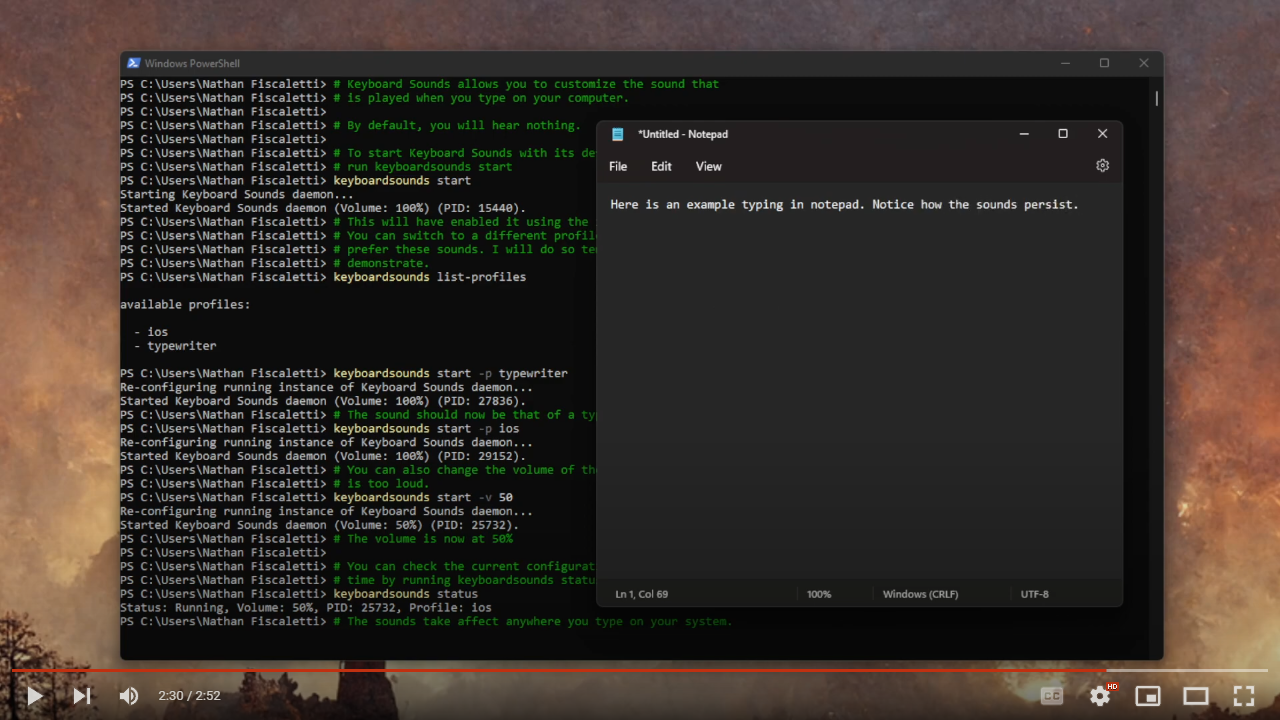Adds the ability to play sounds while typing on any system.
Project description
Keyboard Sounds
$ pip install keyboardsounds
This python package will add the ability to play sounds while typing anywhere on your system. You can also create Custom Profiles for customized audio when typing.
Preview Video
Click to view a preview of the application.
iOS Sounds
In an effort not to directly distribute the iOS keyboard sound effects this package comes with a video recording of an iOS screen including typing in the recording. This recording is loaded at run-time and the audio clips are extracted and stored in memory for use.
See AudioManager.prime_audio_clips for more information.
Usage
Keyboard Sounds vX.X.X
usage:
manage daemon:
keyboardsounds start [-v <volume>] [-p <profile>] [-r]
keyboardsounds stop
keyboardsounds status
manage profiles:
keyboardsounds add-profile -z <zipfile>
keyboardsounds remove-profile -n <profile>
keyboardsounds list-profiles
other:
keyboardsounds version
positional arguments:
{start,stop,status,add-profile,remove-profile,list-profiles}
The action to perform
options:
-h, --help show this help message and exit
-v volume, --volume volume
volume of the sound effects (0-100), default 100
-p profile, --profile profile
sound profile to use, default 'ios'
-r, --repeat repeat the sound effect when the key is held down
-n name, --name name name of the profile remove
-z file, --zip file path to the zip file containing the profile to add
-V, --version show program's version number and exit
Manage Daemon
Action: start
Starts the daemon if it is not running. Otherwise, can be used to re-start it with an adjusted configuration.
# Start with default volume of 100%
$ keyboardsounds start
# Start or reconfigure with a volume of 50%
$ keyboardsounds start -v 50
# Start or reconfigure with a specific profile
$ keyboardsounds start -p typewriter
# Start or reconfigure to allow for key repeat sounds
$ keyboardsounds start -r
Action: status
Checks the current status of the daemon.
$ keyboardsounds status
Action: stop
Stops the daemon if it is running.
$ keyboardsounds stop
Manage Profiles
Action: add-profile
Adds a new profile to the application.
$ keyboardsounds add-profile -z ./my-profile.zip
Action: remove-profile
Removes a profile from the application.
$ keyboardsounds remove-profile -n myprofile
Action: list-profiles
Lists the currently loaded profiles.
$ keyboardsounds list-profiles
Custom Profiles
🛈 Custom Profile Builder Coming Soon
This application supports custom profiles in which you can provide your own WAV files to be used for the different keys pressed.
Creating a Profile
- Create a new directory containing the sounds you wish to use.
- Add a new file to the directory called
profile.json. - Follow the example format below to create the profile.
- Combine the files into a ZIP file. The files must be at the root of the zip file.
You can then add this profile using the add-profile action.
Example Profile
Note: Comments are technically not valid JSON. Make sure you remove them if you choose to use this example as a starting point for your
profile.jsonfile.
{
// The name of the profile.
"name": "myprofile",
// Type should always be "files".
"type": "files",
// References a sound in the "sounds" array.
// This will be used as the default value for any key
// not specified in the "keys" array.
//
// This can either be a single ID from the "sounds" array
// or an array of IDs, from which one will be randomly
// selected each time a key is pressed.
"default": ["key", "key2"],
// This is an array of the different sounds available.
// All sound files should be stored directly in the root
// of the custom profile directory.
//
// Each sound is assigned an ID which can be referenced by
// either the "default" property or by one of the elements
// of the "keys" array.
"sounds": [
{
"id": "key",
"file": "key.wav"
},
{
"id": "key2",
"file": "key2.wav"
},
{
"id": "alt",
"file": "alt.wav"
},
{
"id": "alt2",
"file": "alt2.wav"
},
{
"id": "back",
"file": "back.wav"
}
],
// An array that maps specific keys to specific sounds
// from the "sounds" array.
"keys": [
{
// This can either be a single ID from the "sounds
// array or an array of IDs, from which one will
// be randomly selected each time a key is pressed.
"sound": "back",
"keys": [
"space", "backspace"
]
},
{
"sound": ["alt", "alt2"],
"keys": [
"alt", "ctrl", "shift",
"tab", "enter", "insert",
"home", "page_up", "page_down",
"delete", "end"
]
}
]
}
Project details
Release history Release notifications | RSS feed
Download files
Download the file for your platform. If you're not sure which to choose, learn more about installing packages.
Source Distribution
Built Distribution
Hashes for keyboardsounds-3.2.0-py3-none-any.whl
| Algorithm | Hash digest | |
|---|---|---|
| SHA256 | 0ad289957ce0c2a1754359917d6f56121053c3784f8e44bb63e717966a82cb46 |
|
| MD5 | d532c348125c9756fbfef3e5c3c3bc68 |
|
| BLAKE2b-256 | 95661e73dd41ea570ca4c2613316895259fa02d19b9bbed51d178022d9a94bbe |















